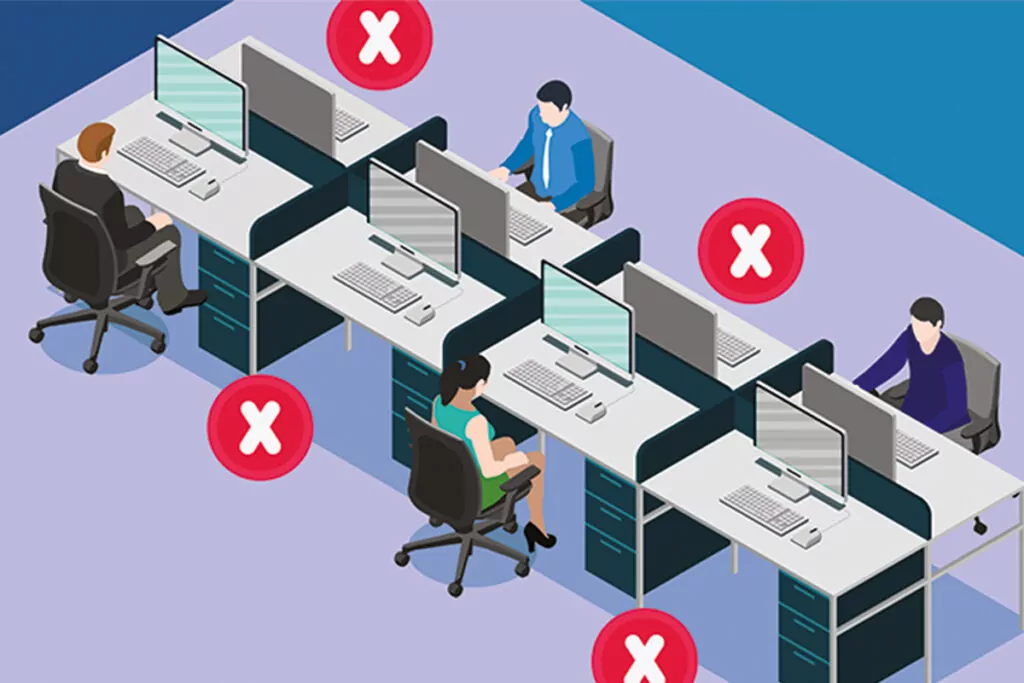Due to the COVID-19 pandemic, most of the UK’s workers have been inside for the past few months – either working from home or on furlough leave. Following UK government advice, high street shops and non-essential businesses have started to reopen as lockdown measures begin to cease. Some staff may be returning to the office soon and within a few months, it’s expected that business and everyday life will return to some degree of ‘normality’.
Having been isolated and stuck inside for the past few months, going back to work may be a difficult transition. To prepare you, we’ve collected some of our favourite content from around the web on how to start the transition to this new type of working.
How To Stay Safe In The Office
With lockdown easing and businesses reopening, you may soon be expected to follow suit. Returning to the office will never be the same than before Coronavirus forced us all inside and remote working became the norm. Many aspects of the workplace will need to be reconsidered when returning to the office, in terms of social distancing, health and safety and additional working requirements.
COVID-19: Returning to the Workplace guide from CIPD explains the need for business owners to review and consider the new working environment. The guide states that many workplace activities like meetings and communal areas will need to be looked at and updated to fit the new social distancing standards.
First, assess the office as it currently stands. For example, can staff maintain a 2-meter distance from one another? How will you manage communal areas like the kitchen or bathrooms? If how the office currently stands will jeopardise distancing, then it’s important to think about moving it around and perhaps staggering working hours for staff returning.
As CIPD states, it’s important to work in close collaboration during this time with your health and safety teams to make the office safe. It may be helpful to add personal protective equipment (PPE) to the office to minimise spread of infection. Adding more soap and sanitiser around the office is beneficial as well as other cleaning arrangements to keep desks, phones, keyboards and computers sanitised.
HR News’ Returning to the Workplace: planning a return for concerned employees goes into depth about health and safety measures and workplace risk assessments. To limit or control the risk of infection, the article recommended the following workplace improvements:
- One-way systems, spacing signs and floor markers
- Bringing your own food, drinks and utensils
- Installing hand sanitiser stations close to contact points

Restore productivity
Having gotten used to your home office and working away from your colleagues, you may find going back to commuting, earlier alarms and less flexible working hours a bit jarring. The workplace may feel overwhelming compared to your setup at home and this could have an impact on your productivity.
Returning to Work After the COVID-19 Pandemic: A 6 Step-Plan from i-sight gives great tips on how to improve productivity and help ease employees back into the office. Making the office feel as normal as possible is an important part of this. While the office will look different due to extra safety measures, making the workspace look like it did before will help employees feel more comfortable and cause little interruption to their work.
Now that we’re all used to working from home, you may find that you feel more productive working away from the office. If this is the case, it might be a good idea to ask your manager or head of department if you can add a few remote working days to your week. It might also be helpful to introduce flexible working hours as colleagues come back. To avoid a spike in Coronavirus cases, businesses will have to stagger employees returning to the office anyway. This is a great way to ease back into ‘regular’ working life.
If you’re worried about your productivity and motivation dimming, try to transition aspects of your home setup to the office. For example, if you found taking short breaks throughout the day was beneficial to your workflow, try implementing this when you return to the office.
Mental health support
This has been a worrying and confusing time for everyone, but lockdown may have been harder for some more than others. Returning to work after becoming comfortable working remotely may prove to be stressful and it’s vital to prioritise mental health around this time.
B2e Media’s 10 Ways to Encourage a Safe Return to the Office After Lockdown offers tips to transition back to work smoothly, safely and positively. A great recommendation that B2e Media mentions is conducting one-on-one interviews with staff. Whether managers are offering this as you return or if you simply ask for one yourself, this is a great way to catchup following lockdown and to discuss any concerns you’re having. For managers, this is a great way to offer support and reassure your colleagues about coming back to the office or back from furlough leave.
Your organisation should offer mental health support and a safe environment for you to express your feelings, whether that’s to another colleague, your manager, head of department or HR team. As we mentioned in our Remote Working Tools guide, it’s important to communicate and check in with your colleagues – not just during isolation but also when you’re back to normal working environments. If you find yourself heading back to the office but a colleague prefers to work remotely, remember to check in with them regularly.

Business Recovery
Whatever your business was like before the lockdown, it won’t be the same once you return. This not only refers to the office atmosphere and distancing measures but also business strategies and procedures.
Cardinus Risk Management’s Returning to Work After Lockdown – A Programme for Safe Return discusses what businesses should do in terms of assessment and continuity. As recommended in the article, following a ‘Prepare, Inform, Prevent and Recover’ strategy will help your business get back on track after the disruption from Coronavirus.
Putting a ‘return to work’ programme in place will ensure the business continues to grow and restore confidence within the organisation, while also supporting those who have returned to the office. Monitoring the effectiveness of working from home is also important, to assess whether productivity dropped or rose and if some colleagues work better that way and if they should be encouraged to do this more often.
Another recommendation is to review and update your Business Continuity Plan. This is a great strategy to jump start recovery and to assess whether your plan before, during and after the outbreak has been effective or if it needs to be worked on.
Staying productive, remotely or otherwise
As COVID, lockdowns and remote working aren’t going anywhere soon for many, being able to have the same level of productivity whether you or colleagues are in the office or remote could make the difference between normal levels of productivity and missing out on opportunities.
As part of this trend, we’ve seen a significant increase in the number of businesses moving to cloud-hosted phone systems.
Chat to us
Want to see how easy (and cheap) it is to get your business properly set up for remote working? Talk to our team!


